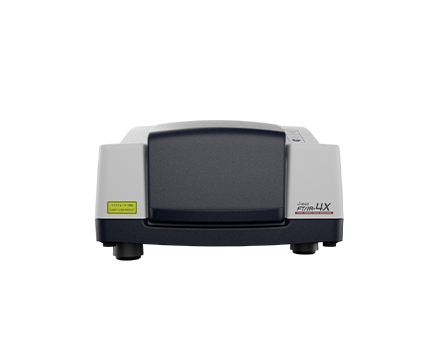FT/IR-4000 and FT/IR 6000 Series FTIR Instrument Validation Software
August 24, 2022
Introduction

When using an analytical instrument in a regulated laboratory, a performance evaluation of the instrument is often required to ensure that it is operating to the required specifications. The FT/IR-4000 and FT/IR-6000 instruments are provided with a [Validation] application as part of the Spectra Manager II Suite. This validation software provides a comprehensive series of tests that can be used to evaluate the continued performance of an FTIR instrument.
The FT/IR-4000 and FT/IR-6000 instrument validation in Spectra Manager II Suite provides a series of test protocols to verify that the instrument is performing to operating specification. [Pass/Fail] criteria are established for each instrument based on individual specifications. The validation function provides tests that compare current performance vs. historical data as well as testing against standard reference materials (with specifications to NIST or some other recognized authority).
Figure 1 outlines the various tests that can be selected. The majority of these tests compare the current instrument performance against data collected during installation. Other tests use Polystyrene and Glass standards included with the instrument. In addition, for regulatory compliance a NIST traceable polystyrene SRM can be used for the performance test. The qualification tests that do not require external standards have been checked within the displayed software dialog. The [Linearity] test requires external linearity standards, such as a solution or other quantitative standard. Specific tests complying with regulatory compliance with US Pharmacopeia (USP), European Pharmacopeia (EP), Japanese Pharmacopeia (JP) or Japan Industrial Standards (JIS) can be selected. Custom tests can also be created to the user’s criteria by manually editing the SRM type and corresponding specification.
The tests are easily performed and the only user input required is the collection of the original historical data at instrument installation (Figure 2). All other performance tests have specified values applied according to the instrument type and the required instrument parameters are specified dependent upon the individual test procedure (Figure 3). When the tests are performed, the software executes each test, prompting the user when to insert the required standards. At the end of the qualification tests, a detailed report is saved and can also printed (Figure 4). The requirements for testing largely depend on the SOP established by the laboratory, however JASCO generally recommends performing these tests at least quarterly or semi-annually.
Conclusion
Spectra Manager II Suite includes a validation application that can be used to evaluate the performance of both the FT/IR-4000 and FT/IR-6000 Series of instruments. These tests are automated and take very little time to perform, individual tests may be selected and used as required by the user to check the instrument is performing to specification.
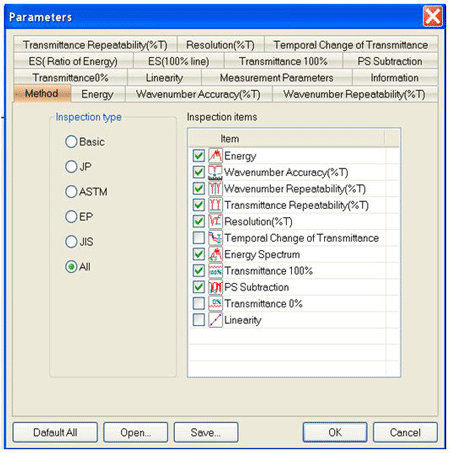
Unchecked items require external standards (not included as standard).
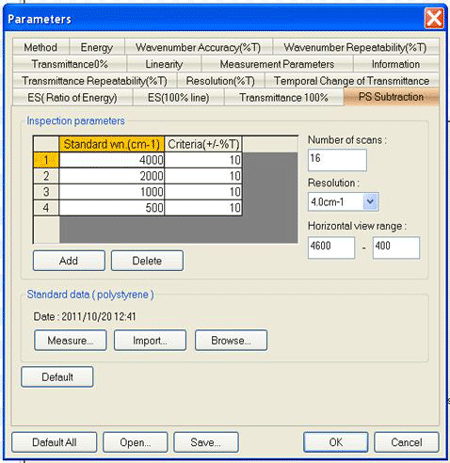
instrument installation, or a previously collected polystyrene standard spectrum can be imported.
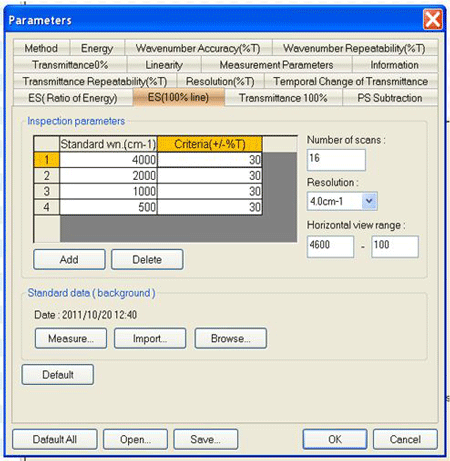
In this dialog, the historical data is also collected or imported by the user.
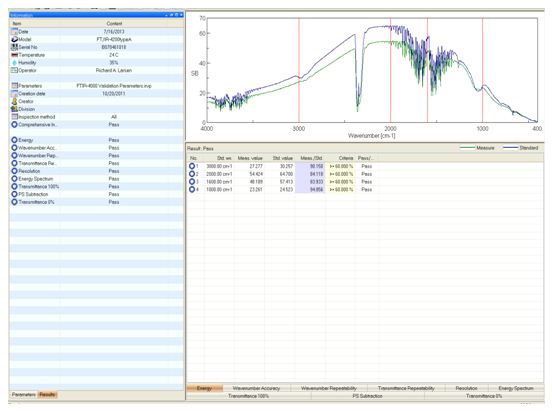
have [Passed] and the results saved electronically and may be printed.
Featured Products:

FT/IR-4000 and FT/IR 6000 Series FTIR Instrument Validation Software
Introduction

When using an analytical instrument in a regulated laboratory, a performance evaluation of the instrument is often required to ensure that it is operating to the required specifications. The FT/IR-4000 and FT/IR-6000 instruments are provided with a [Validation] application as part of the Spectra Manager II Suite. This validation software provides a comprehensive series of tests that can be used to evaluate the continued performance of an FTIR instrument.
The FT/IR-4000 and FT/IR-6000 instrument validation in Spectra Manager II Suite provides a series of test protocols to verify that the instrument is performing to operating specification. [Pass/Fail] criteria are established for each instrument based on individual specifications. The validation function provides tests that compare current performance vs. historical data as well as testing against standard reference materials (with specifications to NIST or some other recognized authority).
Figure 1 outlines the various tests that can be selected. The majority of these tests compare the current instrument performance against data collected during installation. Other tests use Polystyrene and Glass standards included with the instrument. In addition, for regulatory compliance a NIST traceable polystyrene SRM can be used for the performance test. The qualification tests that do not require external standards have been checked within the displayed software dialog. The [Linearity] test requires external linearity standards, such as a solution or other quantitative standard. Specific tests complying with regulatory compliance with US Pharmacopeia (USP), European Pharmacopeia (EP), Japanese Pharmacopeia (JP) or Japan Industrial Standards (JIS) can be selected. Custom tests can also be created to the user’s criteria by manually editing the SRM type and corresponding specification.
The tests are easily performed and the only user input required is the collection of the original historical data at instrument installation (Figure 2). All other performance tests have specified values applied according to the instrument type and the required instrument parameters are specified dependent upon the individual test procedure (Figure 3). When the tests are performed, the software executes each test, prompting the user when to insert the required standards. At the end of the qualification tests, a detailed report is saved and can also printed (Figure 4). The requirements for testing largely depend on the SOP established by the laboratory, however JASCO generally recommends performing these tests at least quarterly or semi-annually.
Conclusion
Spectra Manager II Suite includes a validation application that can be used to evaluate the performance of both the FT/IR-4000 and FT/IR-6000 Series of instruments. These tests are automated and take very little time to perform, individual tests may be selected and used as required by the user to check the instrument is performing to specification.

Unchecked items require external standards (not included as standard).

instrument installation, or a previously collected polystyrene standard spectrum can be imported.

In this dialog, the historical data is also collected or imported by the user.

have [Passed] and the results saved electronically and may be printed.

 Download This Application
Download This Application